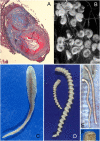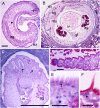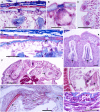Diagnosis of human visceral pentastomiasis
- PMID: 19238218
- PMCID: PMC2643528
- DOI: 10.1371/journal.pntd.0000320
Diagnosis of human visceral pentastomiasis
Abstract
Visceral pentastomiasis in humans is caused by the larval stages (nymphs) of the arthropod-related tongue worms Linguatula serrata, Armillifer armillatus, A. moniliformis, A. grandis, and Porocephalus crotali. The majority of cases has been reported from Africa, Malaysia, and the Middle East, where visceral pentastomiasis may be an incidental finding in autopsies, and less often from China and Latin America. In Europe and North America, the disease is only rarely encountered in immigrants and long-term travelers, and the parasitic lesions may be confused with malignancies, leading to a delay in the correct diagnosis. Since clinical symptoms are variable and serological tests are not readily available, the diagnosis often relies on histopathological examinations. This laboratory symposium focuses on the diagnosis of this unusual parasitic disease and presents its risk factors and epidemiology.
Conflict of interest statement
The authors have declared that no competing interests exist.
Figures





References
-
- Meyers WM, Neafie RC, Connor DH. Pentastomiasis. In: Binford CH, Connor DH, editors. Pathology of tropical and extraordinary diseases. Washington (D.C.): Armed Forces Institute of Pathology; 1976. pp. 546–550.
-
- Khalil GM. Linguatula serrata (Pentastomida) parasitizing humans and animals in Egypt, neighbouring countries, and elsewhere: A review. J Egypt Public Health Assoc. 1972;47:364–369. - PubMed
-
- Arroyo R, Vargas M, Santamaria S. [Pentastomiasis in Costa Rica caused by Linguatula serrata and its differential diagnosis from L. recurvata.] [Article in Spanish.] Rev Latinoam Microbiol. 1986;28:157–166. - PubMed
Publication types
MeSH terms
LinkOut - more resources
Full Text Sources
Medical

